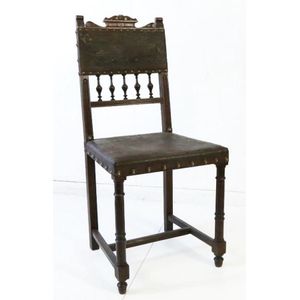Boulle Inlaid Ebonized Whatnot Stand
Antique Boulle inlaid whatnot, held by ebonized turned supports, approx 80.5 cm high, 45.5 cm wide, 35.5 cm depth
You must be a subscriber, and be logged in to view price and dealer details.
Subscribe Now to view actual auction price for this item
When you subscribe, you have the option of setting the currency in which to display prices to $Au, $US, $NZ or Stg.
This item has been sold, and the description, image and price are for reference purposes only.
- Turning - Any part of a piece of furniture that has been turned and shaped with chisels on a lathe. Turned sections include legs, columns, feet, finials, pedestals, stretchers, spindles etc. There have been many varieties and fashions over the centuries: baluster, melon, barley-sugar, bobbin, cotton-reel, rope-twist, and so on. Split turning implies a turned section that has been cut in half lengthwise and applied to a cabinet front as a false decorative support.
- Boulle - Boulle work is the name given to tortoiseshell and metal inlay using brass and sometimes silver, found on furniture and smaller wooden objects. It originated in Italy but was developed by Frenchman Andre Charles Boulle (1642 - 1732) under Louis XIV.
Boulle was appointed Royal Cainet Maker to Louis XIV and designed furniture and clockcases for the monarch.
In preparation, the tortoiseshell and metal were cut together following a design, using a fine fret saw.
In the application of the Boulle, the carcase of piece of furniture was covered with the tortoiseshell which in turn was inlaid with the matched designs in metal, which in turn was elaborately engraved.
The use of Boulle work furniture continued mainly in France until the 19th century. - Inlay - Decorative patterns inserted into the main body of a piece of furniture, generally in wood of contrasting colour and grain, though brass, ivory, ebony, shell and sometimes horn have been used. Inlay may consist of a panel of well figured timber inset into a cabinet door front, geometric patterns, or complex and stylized designs of flowers, swags of foliage, fruits and other motifs. As a general rule, in pieces where the carcase is constructed in the solid, the inlay is relatively simple such as stringing, cross banding and herringbone banding. Where more elaborate and decorative work was required veneer was used. Inlay has been fashionable from at least the latter half of the 17th century, when a variety of elaborate forms were developed
This item has been included into following indexes:
Visually similar items

Antique French walnut marble topped side table.lamp table, with caned under shelves
Sold by
in
for
You can display prices in $Au, $US, $NZ or Stg.

A finely carved mahogany Chinoiserie display cabinet with gilded detailing, French circa 1880 168 cm high, 100.5 cm wide, 39.5 cm deep
Sold by
in
for
You can display prices in $Au, $US, $NZ or Stg.

Edwardian side chair. Pressed leather seat & back; spindle decoration. Restored.
Sold by
in
for
You can display prices in $Au, $US, $NZ or Stg.

A Georgian mahogany bedside table with drawer. 72 cm high, 42 cm wide, 40 cm deep
Sold by
in
for
You can display prices in $Au, $US, $NZ or Stg.
